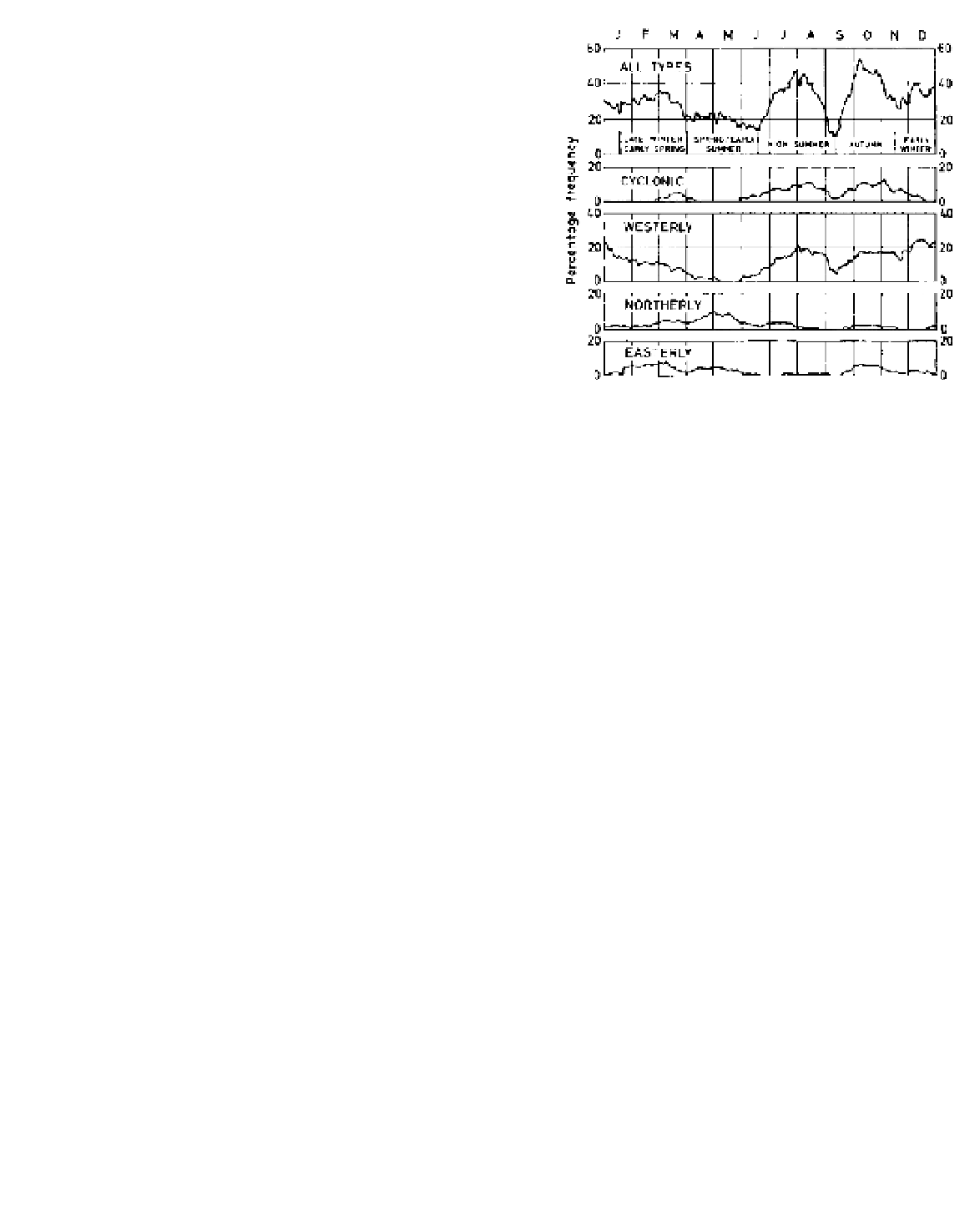Geoscience Reference
In-Depth Information
2
Around the second week in September, Europe
and Britain are affected by a spell of anticyclonic
weather. This may be interrupted by Atlantic depres-
sions, giving stormy weather over Britain in late
September, although anticyclonic conditions again
affect central Europe at the end of the month and
Britain during early October.
3
A marked period of wet weather often affects
western Europe and also the western half of the
Mediterranean at the end of October, whereas the
weather in eastern Europe generally remains fine.
4
Anticyclonic conditions return to Britain and affect
much of Europe in about mid-November, giving rise
to fog and frost.
5
In early December, Atlantic depressions push east-
ward to give mild, wet weather over most of Europe.
Figure 10.8
The frequency of long spells (twenty-five days or
more) of a given airflow type over Britain, 1898 to 1947. The
diagram showing all long spells also indicates a division of the year
into 'natural seasons'.
Source
: After Lamb (1950), by permission of the Royal Meteorological
Society.
In addition to these singularities, major seasonal
trends are recognizable. For the British Isles, Lamb
identified five
natural seasons
on the basis of spells of
a particular type lasting for twenty-five days or more
during the period 1898 to 1947 (Figure 10.8). These
seasons are as follows:
at this time of year can be of very different types, so
that in some years it is midwinter weather, while in
other years there is an early spring from about late
February.
1
Spring to early summer
(the beginning of April to
mid-June). This is a period of variable weather
conditions during which long spells are least likely.
Northerly spells in the first half of May are the
most significant feature, although there is a marked
tendency for anticyclones to occur in late May to
early June.
2
High summer
(mid-June to early September). Long
spells of various types may occur in different years.
Westerly and northwesterly types are the most
common and they may be combined with either
cyclonic or anticyclonic types. Persistent sequences
of cyclonic type occur more frequently than anti-
cyclonic ones.
3
Autumn
(the second week in September to mid-
November). Long spells are again present in most
years. Anticyclonic types are mainly in the first half,
cyclonic and other stormy ones generally in October
to November.
4
Early winter
(from about the third week in November
to mid-January). Long spells are less frequent than in
summer and autumn. They are usually of westerly
type, giving mild, stormy weather.
5
Late winter and early spring
(from about the third
week in January to the end of March). The long spells
5 Synoptic anomalies
The mean climatic features of pressure, wind and
seasonal airflow regime provide only a partial picture of
climatic conditions. Some patterns of circulation occur
irregularly and yet, because of their tendency to persist
for weeks or even months, form an essential element of
the climate.
Blocking patterns
are an important example. It was
noted in Chapter 7 that the zonal circulation in mid-
latitudes sometimes breaks down into a cellular pattern.
This is commonly associated with a split of the jet
stream into two branches over higher and lower mid-
latitudes and the formation of a cut-off low (see Chapter
9H.4) south of a high-pressure cell. The latter is referred
to as a
blocking anticyclone
since it prevents the
normal eastward motion of depressions in the zonal
flow. Figure 10.9 illustrates the frequency of blocking
for part of the northern hemisphere with five major
blocking centres shown (H). A major area of blocking
is Scandinavia, particularly in spring. Cyclones are

